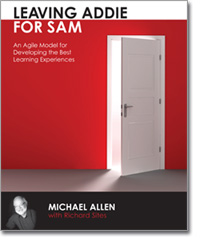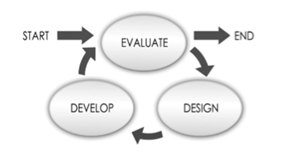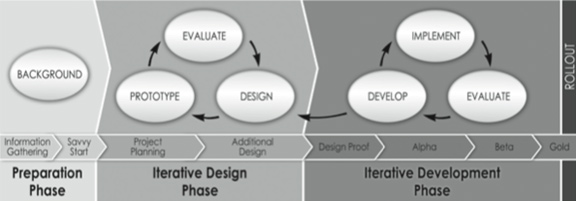From the outset of his latest book, Leaving ADDIE for SAM, Michael Allen tells us this is not a book about instructional design (“at least it wasn’t intended to be,” he says). Having spent the last few days engrossed by its contents, I am here to tell you it is most certainly a book that makes you think about instructional design. The successes and the failures. The steps and the processes. The SMEs and the content. And the meetings … oh, the meetings.
 For the lucky among us, we’ve
seen extraordinary learning programs created by teams of engaged stakeholders
and creative designers and developers that produce real, measurable changes in
performance. For most of us, unfortunately, we often see programs created by
those same stakeholders, designers, and developers producing dismal results at
best. These programs look like training (“Hey,
we’ve got a pre-test and post-test.”). They sound like training (“Upon completion of this course, you will be
able to….”). Some of them even smell like training (“Mmm … coffee and doughnuts.”). And while
most instructional designers will argue that they used the time-tested ADDIE
model to produce those training programs, Leaving
ADDIE for SAM will (one hopes) challenge them to think about some of the
limitations and challenges of such a linear process and look to the iterative
and collaborative opportunities afforded by SAM, the successive approximation
model.
For the lucky among us, we’ve
seen extraordinary learning programs created by teams of engaged stakeholders
and creative designers and developers that produce real, measurable changes in
performance. For most of us, unfortunately, we often see programs created by
those same stakeholders, designers, and developers producing dismal results at
best. These programs look like training (“Hey,
we’ve got a pre-test and post-test.”). They sound like training (“Upon completion of this course, you will be
able to….”). Some of them even smell like training (“Mmm … coffee and doughnuts.”). And while
most instructional designers will argue that they used the time-tested ADDIE
model to produce those training programs, Leaving
ADDIE for SAM will (one hopes) challenge them to think about some of the
limitations and challenges of such a linear process and look to the iterative
and collaborative opportunities afforded by SAM, the successive approximation
model.
SAM: The Successive Approximation Model
In Part I of Leaving ADDIE for SAM, Allen outlines four necessary criteria for the ideal process model, each of which are met by SAM.
1. The Process Must Be Iterative
Development done in small steps with frequent early evaluation allows for changes that can be modified or reversed at a time when changes cost the least.
2. The Process Must Support Collaboration
Project teams that collaborate effectively take advantage of the ideas, opinions, experiences, and knowledge of team members, while avoiding bureaucracy and indecision through clear role definitions, decision-making, documentation, and process flows.
3. The Process Must Be Efficient and Effective
Recognize that no project is perfect, outline where energy and resources should be focused and produce usable projects as quickly as possible.
4. The Process Must Be Manageable
A manageable process allows for the completion of projects on time and on budget with a product that meets established quality criteria.
To put SAM into practice, design teams have a couple of options. SAM1 is a basic process well suited for smaller projects led by an individual or small team where no specialized technical skills (e.g., software programming or video production) are required (Figure 1). The process cycles through three iterations with steps familiar to instructional designers—evaluation/analysis, design, and development—allowing teams to create and refine prototypes along the way. Ideas and assumptions are discussed and tested early, thus allowing for relatively quick development of a usable product after only a couple of iterations.

Figure 1: Basic Successive Approximation Model—SAM1
For projects with more content or eLearning development that requires more advanced programming skills, SAM2 is useful (Figure 2). In this model, work is divided into three distinct phases—preparation, iterative design, and iterative development.
- Preparation allows the team to gather background information and conduct a “savvy start”—a brainstorming event bringing the design team and stakeholders together to review information and create initial prototype ideas.
- The iterative design and iterative development phases are broken down into smaller incremental steps, allowing teams to make decisions and refine prototypes early on.

Figure 2: extended successive approximation model—SAM2
The bottom line
On multiple occasions, Allen clearly offers that the best model for any designer or developer is the one that works well for a particular organization—a model that consistently produces effective learning outcomes on time and on budget. If the ADDIE model works for you, Allen argues, by all means use it! He offers SAM as an alternative process utilizing similar tasks, without the traditional step-by-step requirements of the ADDIE model. That said, Allen does contend that SAM has its challenges, including work refined too early in the process and a tendency towards perpetual cycling. For teams thinking of using the SAM process, including my own, I offer the following advice:
- Be aware of the inherent challenges in any instructional design model or process.
- Involve all project stakeholders (including targeted learners and their supervisors) early and often.
- Consider content breadth before depth.
- Avoid the first cousin of analysis paralysis—the iteration station. Three cycles is enough!
- Be open, and welcome feedback and changes to prototypes.
Perhaps the biggest bang for your buck is found throughout parts two and three of the book. Chock-full of samples, including a “savvy start” meeting agenda, multiple prototypes, a project plan, review checklists, and more, Leaving ADDIE for SAM will be an indispensable resource for instructional designers and developers looking for a fresh approach that’s less onerous and process-bound and more iterative and driven by creativity. Tell me, will you be Leaving ADDIE for SAM?
Bibliographic information
Allen, Michael. (2012) Leaving ADDIE for SAM: An Agile Model for Developing the Best Learning Experiences. Alexandria, VA: ASTD Press. ISBN: 978-1-56286-711-9. 208 pages.
Publication date: September 26, 2012
Publisher’s price: $38.95 for paperback or PDF
Barnes & Noble: $28.17 for paperback only
Amazon: Price information not available at the time of review

